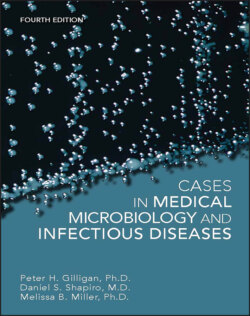Читать книгу Cases in Medical Microbiology and Infectious Diseases - Melissa B. Miller - Страница 20
Gram stain
ОглавлениеThe most frequently utilized stain in the microbiology laboratory is the Gram stain. This stain differentiates bacteria into two groups. One is referred to as Gram positive because of its ability to retain crystal violet stain, while the other is referred to as Gram negative because it is unable to retain this stain (see Fig. 1). These organisms can be further subdivided based on their morphological characteristics.
The structure of the bacterial cell envelope determines an organism’s Gram stain characteristics. Gram-positive organisms have an inner phospholipid bilayer membrane surrounded by a cell wall composed of a relatively thick layer of the polymer peptidoglycan. Gram-negative organisms also have an inner phospholipid bilayer membrane surrounded by a peptidoglycan-containing cell wall. However, in the Gram-negative organisms, the peptidoglycan layer is much thinner. The cell wall in Gram-negative organisms is surrounded by an outer membrane composed of a phospholipid bilayer. Embedded within this bilayer are proteins and the lipid A portion of a complex molecule called lipopolysaccharide. Lipopolysaccharide is also referred to as endotoxin because it can cause a variety of toxic effects in humans.
Because of their size or cell envelope composition, certain clinically important bacteria cannot be seen on Gram stain. These include all species of the genera Mycobacterium, Mycoplasma, Rickettsia, Coxiella, Ehrlichia, Chlamydia, and Treponema. Yeasts typically stain as Gram-positive organisms, while the hyphae of molds may inconsistently take up stain but generally will be Gram positive.
Gram stains can be performed quickly, but attention to detail is important to get an accurate Gram reaction. One clue to proper staining is to examine the background of the stain. The presence of significant amounts of purple (Gram positive) in the epithelial cells, red or white blood cells, or proteinaceous material, all of which should stain Gram negative, suggests that the stain is under-decolorized and that the Gram reaction of the bacteria may not be accurate. This type of staining characteristic is frequently seen in “thick” smears. The detection of over-decolorization is much more difficult and is dependent on the observation skills of the individual examining the slide.
